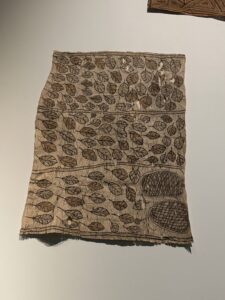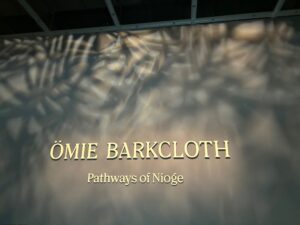Lost Innocence
Untouched by a crowded, commercial, corrupt-tempting world
unblemished by greed and fear of need and fame
protected by impenetrable jungle wilderness
and thick mountain mist, an unknown world, hidden from t
enticles of progress enigmatic, endangered as a planet humans
want to conquer. Discovered by the clambering, climbing, curious
determined to find the last small pocket of skythe Ömie people are
found living their beauty of being alive, honouring their creative
human spirit with art, story, song in forever land.
Their world, their inspiration.twig, tusk and teeth,
leaf and twine to weave and plait, vine, feather, bone,
and web, wood and bark, mystery of the eye and their
mountain that nourishes them. They write their story
and adorntheir bodies in design, decoration, pattern
with minute details of leaf, snake backbone, hip joint
of mountain frogs, of beetle jaw and spider.
In cyclic beat of time, coloured,in plant yellow, black
and brick reds. We stand back and learn of a world
we have lost. Of innocence, simplicity and beauty
and now found, it is lost once again.
Colleen Keating



;
REVIEW
Ömie barkcloth:

Pathways of nioge is currently on display on the fourth floor of the University of Sydney’s Chau Chak Wing Museum. Upon entering the gallery space, one is met with a black title wall, and illuminating the text design, is a creative and understated use of exhibition lighting. It is employed throughout the entirety of the exhibition, giving one the immersive feeling of almost being situated within the shadows, and silhouettes of the rainforest highlands of Northern (Oro) Province, Papua New Guinea.
The Ömie people are a distinct cultural group with their own language; a population of around two thousand lives in a series of seven main villages and many more hamlets. Their region in the Mount Lamington Huvaemo, and Mount Obo foothills – close to Kokoda – is sacred to them as the site of their creation stories. Their art is prolific and diverse.
Ömie tapa or nioge in Ömie language is beaten bark cloth, made from the inner bark, or bast, of certain rainforest fig trees including banyan to give a brown finish, and the paper mulberry tree – mori arobe, for the whitish tapa. The bark is cut, then the outer bark is cleaned off to make the inner bark or bast ready for beating. Drops of water are continually sprinkled over the bark as it is beaten to soften it. Paint dyes come from various roots, bark, leaves, fruit, seeds, and nuts. These include combinations of natural plant materials, ash, and water.
The works that comprise the exhibition form the basis of the largest public collection of Ömie nioge, donated to the Chau Chak Wing Museum over the last five years by oceanic art collector and dealer Todd Barlin, who acquired much of the work from fellow collector, and dealer David Baker.
This exhibition is full of vibrant and arresting works, striking for their diversity of size, shape, colour, and symbolism. Many of the works are displayed on large, dark, floating walls, allowing you to walk around and view them while moving in and out of the light. The large white walls of the gallery space are subdued by the creative lighting design. This gives the exhibition more depth overall, and furthers the geometric pathways of nioge design that are the focus.

An added bonus for us on our visit to the Chau Chak Wing Museum was that one of the of curators Rebecca Conwdaughter of Jan took us on a conducted tour of the exhibition and in the afternoon we enjoyed a question and answer panel discussion with Drusilla Mojeska who has been one of the first to trek into the mountain (Mt. Lamington) and befriend the ömie women amd her biographer Bernadette Brenton . Then lunch in the cafe indoor/outdoor at the Museum.

